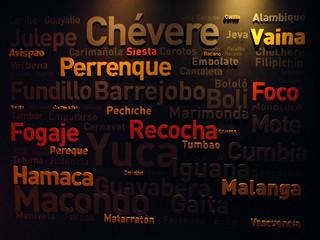2103’s seventh most popular post is about one of my soapboxes, my “hills to die on.” I’m convinced that the way most of us approach vocabulary in the world language classroom is almost completely contradictory to brain research. Read on for four classroom habits that enrich student vocabulary where it counts – in their long-term memory.
 A while ago this comment was left on the old Musicuentos site, on the post “Do something drastic – kick the vocab quiz“:
A while ago this comment was left on the old Musicuentos site, on the post “Do something drastic – kick the vocab quiz“:
“Can you give us some examples of what activities you do to ensure mastery of the vocabulary? And do you have any advice on how to promote this kind of teaching/learning in large departments with different teaching philosophies?”
Perhaps I’ll address the second issue a little later (and that has been a suggested topic for #langchat) but here I’ll just outline a few habits that I’ve found create long-term memory for students’ vocabulary without rote memorization, cramming, or quizzing. I almost called this post “four activities that enrich vocabulary” but I changed it to “habits” because if you’re really serious about cementing vocabulary in long-term memory instead of resorting to temporary, ineffective methods like quizzing, these need to be habits among you and your students, not just occasional activities. Especially as I focus this spring on deepening my Spanish 3 students’ very shallow vocabulary, I need to remind myself of these too.
Storytelling
As I watch my own children acquire and refine language, it seems to me they do this primarily in two ways. One is actual experience; that is, I point to my husband and say “Papi” and they learn that the word that refers to their father is Papi. The other way is through stories. My oldest is three and a half now, in preschool, and she’s a voracious “reader.” We have to limit how many books she can look through after she goes to bed because last night she spent an hour and fifteen minutes “reading” her books before I told her to put them down and go to sleep. She will ask anyone to read her a story. Also, every day on the way to school and on the way home, she’ll say, “Mami, will you tell me a silly story please?” She taxes my imagination (and gives me lots of Spanish storytelling practice) with her demands for a silly story. I don’t believe this is a personality characteristic. I believe it’s because in our house, reading and stories are a way of life. She’s been interacting with stories since Pequeño Panda was her favorite book to look at during her infant tummy time.
In the classroom, we frequently have to rely on virtual worlds like the internet or (blech) textbooks to provide students with the experience that builds vocabulary. But storytelling – you can do that anytime. Take your target vocabulary and goals and spin a story. Spin another one with the same target, same goals. Then invite students to do the same. You’ll be amazed at how fast and well they deepen their vocabulary.
Investigating themes
In graduate school, I spent a summer teaching five Saudi Arabian men and one Venezuelan girl in an intensive English program. I didn’t know anything about storytelling yet, but I learned that themes teach. In fact, that was the title of a section of my reflection notebook at the end of the experience. I had a stuffed prairie dog that we named Fifi and she became an integral character in demonstrating almost every grammar point we investigated (it was a grammar class). I even titled my end-of-class notebook “Where’s the Fifi?” -the Saudis’ favorite question- and in our class photo, there was Fifi, right in Sultan’s hands.
Repetitious, thematic characters aren’t the only way themes unify seemingly random vocabulary to encode it in students’ memory. Of course, investigating thematic topics is vital. My best example of this is a unit in Spanish 3 that is mostly about narrating stories in the past but in order to do this, we spend a lot of time talking about the rescue of Ingrid Betancourt, 3 Americans, and 11 Colombian police from the FARC in July 2008. I tell the story, students make a flipbook about it, all four of their unit assessments have to do with it, and this year they even made a little movie about it. Result: at the end of the unit, they were throwing around words like rescate, selva, and secuestro without even thinking. How’s that for depth of vocabulary?
Capitalizing on humor
If you haven’t read Brain Rules, you really should. It’ll revolutionize how you approach student learning as you learn what the research says about how our brains really encode information. One principle that stuck with me is that humorous situations encode very strong long-term memories.
The problem with this is that while you can sometimes plan this, the best situations happen by surprise (which, incidentally, makes them even better, in terms of memory). The key is to grab on them when they do happen, make a big deal out of them, and keep making a big deal out of them. Last year for my Spanish 3 fall final, which involves students telling a true or fictional story, one of my junior boys made up a story about him and his family eating ladillas at a seafood restaurant in Florida. I found it curious I didn’t know what he was talking about, since I thought I knew most of the words for things one might eat at a seafood restaurant. I had a nagging thought of what he might be talking about, but I thought, no, surely not. But yes, when I asked, he said, “It’s crabs.” I looked it up quickly and asked, “If I say someone has crabs, do you know what I mean?” His cheeks went several shades darker and it was one of the favorite moments all year for the entire class. Now all of us know the word ladillas. Perhaps it’s not the most useful vocabulary, but it’s a good example of how humor helps memory along.
Reading
After you achieve a certain level of proficiency, the vast majority of your new vocabulary acquisition comes through reading. For example, I acquired the word esgrima by reading Allende’s Zorro and morral from reading Betancourt’s book. Not from looking them up – but from seeing them in context over and over and over again. Provide your students with regular, guided opportunities to read in class, and encourage them to read outside of class. For more on how we use novels in class, look through posts tagged reading. I also highly recommend the leveled novels from TPRS Publishing. To further enhance memory, try to do more pleasure reading than content like news articles.
For more ideas on how students can enrich their own vocabulary by interacting with language in meaningful ways outside of class, look at the posts about my very popular out-of-class homework activity: the original post It’s time for them to use their time, as well as Design your own final exam,the Google doc of my class’s weekly activity options and More student choice in homework.
Photo credit: Luis Alveart



